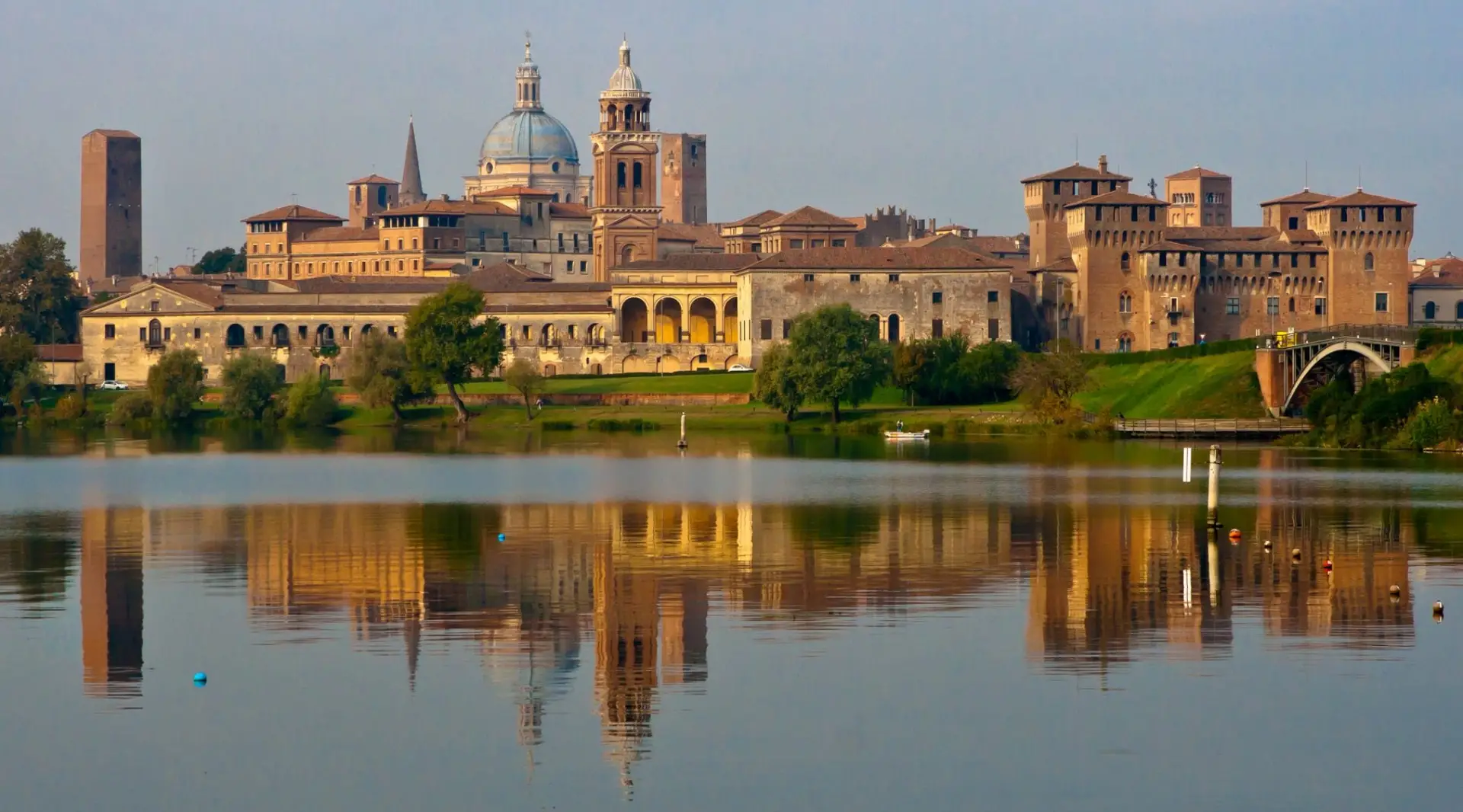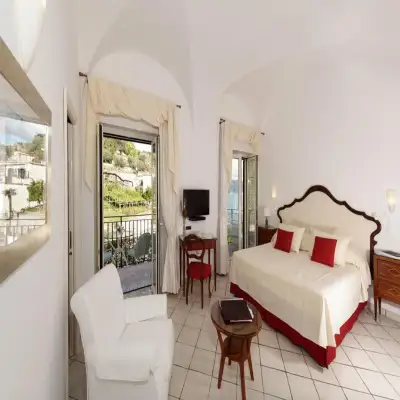
Boutique Hotels in Mantua
FAQs
If you’re wise enough to take a trip to Mantua, here are ten ways to ensure you get the most out of your vacanza.
1. Go gaga for the Gonzagas
For visiting culture vultures, this is the big hitter. The Gonzagas’ royal residence, the Palazzo Ducale (Ducal Palace), is a majestic, overwhelming maze of gardens and galleries, chapels and courtyards, statues, staircases and frescoes covering around 34,000 square metres. Approach this behemoth via the Piazza Sordello, which is flanked by the Palazzo del Capitano and the Magna Domus – two of the most ancient buildings, with distinctive spiky silhouettes. Once inside (consider a guided tour to get the most out of the 500 or so rooms), the most famous sight is that of Mantegna’s stunning frescoes in the Camera degli Sposi (Wedding Room). The Gonzagas befriended some major artists over the course of their dynasty, and the results of these associations are everywhere, offering fascinating glimpses into the lives of the times.
2. Dig into a dish of donkey
The local specialties that Mantua is famous for include pumpkin ravioli and donkey stew. For adventurous meat eaters, stracotto d’asino is unmissable – a thick, dark delicacy that the locals are extremely proud of, thank you very much, so don’t even think about asking for a substitute ingredient. Do check ahead to see if it’s on that night’s menu, though, to avoid disappointment.
If the thought of consuming cute long-eared mammal makes you queasy, sweet and savoury tortelli di zucca – pumpkin ravioli – are widely available and extremely good. For top-notch versions of these dishes, there are some extremely high-class restaurants within reach of Mantua if you want to splash out – the triple-Michelin-starred Dal Pescatore, for example – while within the city itself, consider fine bistro Aquila Nigra. A more down-to-earth but still excellent option for local dishes is L’Ochina Bianca, right in the heart of the old city.
3. Roll with Rigoletto
On a corner of the Piazza Sordello is a beautiful little 15th-century house with a small, square front garden, in the centre of which is a wonderfully realistic yet strange bronze statue of a court jester. This is Rigoletto, a character from Verdi’s opera of the same name. Though Verdi originally wanted to set the story in Paris, the plot’s criticisms of royalty would not have gone down well in the court of the Hapsburgs, so the scenario was transferred to Mantua. The opera was a smash hit when it premiered in Venice, and the invented legend subsequently took hold – Mantuan locals named this house as the ‘real’ residence of the poor hunchbacked Fool. This building actually used to be the cathedral’s parsonage, but it makes a superb setting for opera fans to explore.
4. Stock up on sausage
Giovanni’s salumeria – sausage shop – might be a local legend, but it still feels like a thrilling discovery every time you push open the door. Set on one of the city’s gorgeous pedestrianised terracotta alleyways, this tiny gourmet’s Aladdin’s cave is stuffed wall to wall and floor to ceiling with charcuterie, cheeses, preserved fruits, wine, oils and vinegars and more. Part of the joy of visiting and filling your bags with goodies is Giovanni himself, who is endlessly cheery, generous with his samples and patient with Instagrammers. The perfect place to pick up antipasti for a picnic lunch, washed down with some fizzy red local Lambrusco.
5. Sip a Caravatti cocktail
Mantua’s layout is ideal for long, leisurely evening walks or passeggiata, which some believe can be elevated into an art form. You might not quite crack it during your stay, but you can certainly enjoy yourself exploring the city’s streets, gardens, bridges and palaces on foot as the sky begins to darken.
One thing you can do just like a local is to punctuate your peregrinations with a classy aperitivo (negroni or Aperol spritz – most bars offer a free buffet as well) and watch the world go by – specifically at Bar Caravatti, just round the corner form the Palazzo Ducale. Signor Caravatti is a past master, entertaining all Mantua at some point during the day – plus, he holds the recipe to a cocktail made with wine and aromatic bitters that his family invented on the site in 1865.
6. Vroom like a vespista
It couldn’t get more delightfully Italian than zooming around the picturesque cobbled streets of the ancient city on a gleaming Vespa. In 2014, Mantua hosted the biggest Vespa rally in history, with over 10,000 vespisti wheeling their way to the city from all over the world for a three-day celebration of the iconic brand – a proud moment for the local Vespa club, which has been going since 1948. All in all, 32 countries and 310 clubs were represented, participating on a 10km ride around the city that drew crowds of fascinated spectators. From the gleaming new models on display to crazily customised vintage versions, one thing was clear – Vespas are a serious business around here. Get the look (and a fantastically convenient way of exploring the city and surrounds) by hiring your own – the tourist office will be able to put you in touch with reputable local businesses.
7. Be seduced by Sabbioneta
A short trip out of the city is the ancient commune of Sabbioneta – it means ‘Sandy’ in Italian, named for the riverside soil it rests on. The creation (naturally) of a Gonzaga (Vespasiano I, to be precise), Sabbioneta was listed as a world heritage site by UNESCO in 2008, who declared it to be a perfect example of Renaissance urban planning. The ancient centre is superbly preserved and also boasts an efficient tourist information centre. Less than an hour from Mantua, this makes for an easy day trip. Bring a picnic from Giovannu’s salumeria (see above) or explore the range of local hostelries for more takes on pumpkin pasta.
It was Vespasiano’s dream to turn his tiny ducal seat into the ideal city – he was even buried here. The project was finished in 1591 and features gardens, palaces, theatres (including the first modern free-standing theatre) and churches aplenty, plus a historic synagogue and Hebrew printing press.
8. Tour Palazzo Te
Back to Mantua, and a site that would once have been beyond the walls of the old city, but which feels central today. This is where Federico II Gonzaga, in 1524, commissioned his villa suburbana, or countryside pleasure palace. Designed by painter and architect Giulio Romano, a pupil of Raphael, it’s a mannerist dream – as you enter, the vast square cloistered courtyard can take your breath away. More than just another beautiful building, though, the Palazzo’s original frescoes are preserved, giving the appropriate ducal magnificence to hall after hall and room after room. The gorgeous paintings show Olympian banquets, stylised horses and some very destructive giants – and they’re lucky to still be around. After hosting nobility for centuries, the Palazzo suffered terribly in 1630 during the War of the Mantuan Succession: an army of mercenaries not only infected the local population with a terrible plague, but thoroughly looted the Palazzo, leaving it all but empty.
9. Set sail around the city
Mantua’s magical lakes cry out for a bit of on-water sauntering. A number of local companies offer trips, which range from around €9 for a 1.5-hour trip up to €15 for a five-hour excursion to San Benedetto Po. If you’re feeling really nautical, you can even sail all the way to Venice for the day (€77).
Closer to home around Mantua, you can observe beautiful flora and fauna, as well as stunning views of the ancient city from the water. Some companies, like Ave Maria, even have bikes on board so you can stop off for leisurely exploring of the surrounding areas during longer trips. Another good option is the Mincio organisation, professional boatmen who have encyclopaedic knowledge of the slow, swampy waterways and the fishing villages around Mantua. It’s a much less touristy feel and the friendly boatmen love to talk about the flowers, plants, fish and birds that you’ll see en route. Tours run from March to November and must be booked in advance.
10. Bike trail
Lombardy is both stunning and largely flat, making it ideal for exploring by bicycle (preferably in spring or autumn, when the temperatures are less punishing). Starting from Mantua, a 20km round trip can take in the fabulous Bosca Fontana nature reserve, with gorgeous views of the city. The flat terrain also makes it possible to reach neighbouring cities like Parma and Peschiera as part of a regional tour; cycling groups are a common sight here and there are plenty of services to cater for tourists on two wheels.

